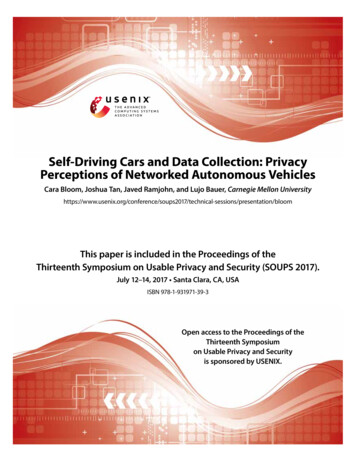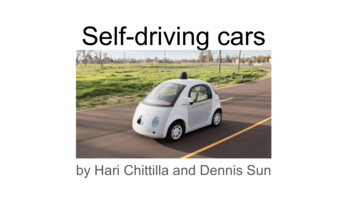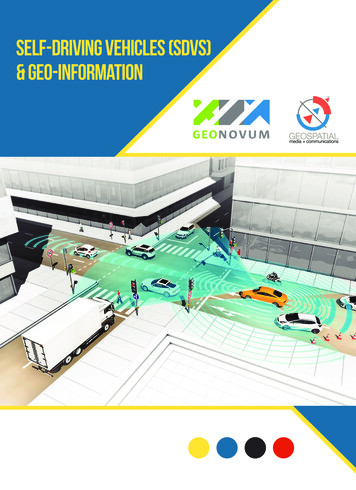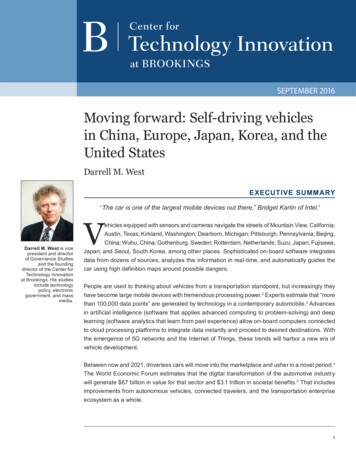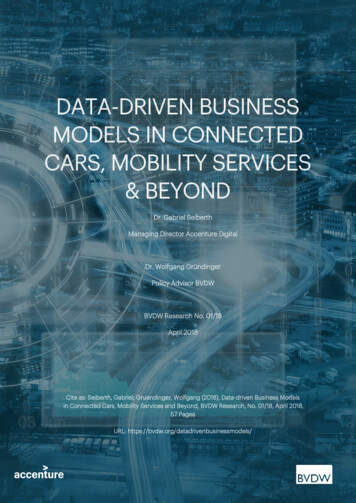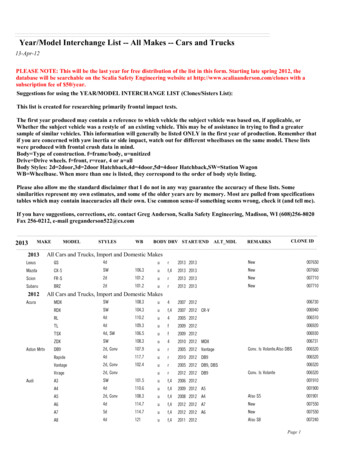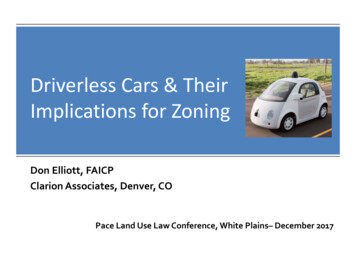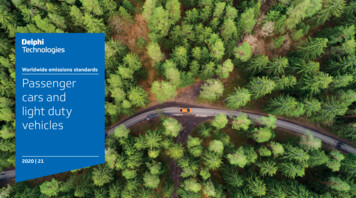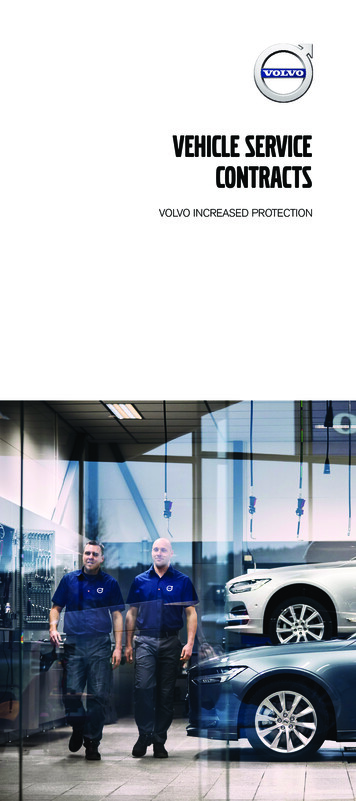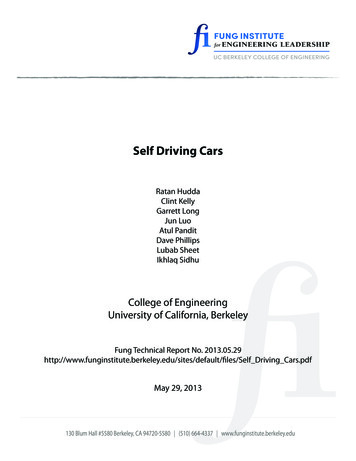
Transcription
Self Driving CarsRatan HuddaClint KellyGarrett LongJun LuoAtul PanditDave PhillipsLubab SheetIkhlaq SidhuCollege of EngineeringUniversity of California, BerkeleyFung Technical Report No. tes/default/files/Self Driving Cars.pdfMay 29, 2013130 Blum Hall #5580 Berkeley, CA 94720-5580 (510) 664-4337 www.funginstitute.berkeley.edu
The Coleman Fung Institute for Engineering Leadership,launched in January 2010, prepares engineers andscientists – from students to seasoned professionals –with the multidisciplinary skills to lead enterprises of allscales, in industry, government and the nonprofit sector.Lee Fleming, Faculty Director, Fung InstituteHeadquartered in UC Berkeley’s College of Engineeringand built on the foundation laid by the College’sCenter for Entrepreneurship & Technology, the Fung Institutecombines leadership coursework in technology innovationand management with intensive study in an area of industryspecialization. This integrated knowledge cultivates leaderswho can make insightful decisions with the confidence thatcomes from a synthesized understanding of technological,marketplace and operational implications.Charles GiancarloAdvisory BoardColeman FungFounder and Chairman, OpenLink FinancialManaging Director, Silver Lake PartnersDonald R. ProctorSenior Vice President, Office of the Chairman and CEO, CiscoIn Sik RheeGeneral Partner, Rembrandt Venture PartnersFung ManagementLee FlemingFaculty DirectorIkhlaq SidhuChief Scientist and CET Faculty DirectorRobert GleesonExecutive DirectorKen SingerManaging Director, CETCopyright 2013, by the author(s).All rights reserved.Permission to make digital or hard copies of all or part of this workfor personal or classroom use is granted without fee providedthat copies are not made or distributed for profit or commercialadvantage and that copies bear this notice and the full citation onthe first page. To copy otherwise, to republish, to post on servers orto redistribute to lists, requires prior specific permission.130 Blum Hall #5580 Berkeley, CA 94720-5580 (510) 664-4337 www.funginstitute.berkeley.edu
Abstract: Since its inception of the commercial auto industry in the late 1890s, cars have become increasingly safe and convenient. Recently, carmakers have begun to introduce advanced driver-assistancesystems such as adaptive cruise control (which automates accelerating and braking) and active lane assist(which automates steering.) These systems have become capable enough that new luxury vehicles candrive themselves in slow-moving highway traffic. Research into autonomous cars has progressed remarkably since the first demonstrations in the 1980s. In 2010, four driverless vans traveled from Italy to China.In August of 2012, Google announced that its self-driving cars had completed over 300,000 miles ofaccident-free autonomous driving. Although self-driving cars may still seem like science fiction, Google,many industry analysts, auto suppliers, and carmakers project that such cars will be available before 2020.This report begins by describing the landscape and key players in the self-driving car market. Current capabilities as well as limitations and opportunities of key enabling technologies are reviewed, along with adiscussion on the impact of such advances on society and the environment. This report also reviews legaland regulatory uncertainties. Finally, predictions about changes in the car-industry are made, includingpotential industry winners and losers.130 Blum Hall #5580 Berkeley, CA 94720-5580 (510) 664-4337 www.funginstitute.berkeley.edu
Insights in Engineering Leadership White PaperBackground and ObservationFor generations, the automobile industry has been a source of innovation and economic growth. Theability to drive is a symbol of mobility and independence that spans generations. Clearly,automobiles play a significant role in our lives and afford many benefits to society.Yet for all the benefits conferred on society, no other invention in the history of civilian technologyhas caused as much harm as the automobile. Every 30 seconds, someone dies in a traffic accident,adding up to well over 1 million deaths each year1. In the U.S., automobile accidents are the leadingcause of death for people between the ages of 3 and 34. Moreover, human error is the cause of over90% of automobile accidents. 2In addition, the inefficiencies related with the automobile usage is staggering. Most automobiles situnused more than 95% of their lifespan, and a freeway operating at maximum efficiency hasautomobiles on only 5% of its surface. In congested urban areas, 40% of all gasoline used is spentwhen cars circle to look for parking spaces4. Furthermore, in some U.S. cities, parking lots comprisemore than a third of the land, becoming the single salient landscape feature of our builtenvironment3.Data from the U.S. Department of Transportation also evokes concerns about quality of life. Itestimates that people spend an average of 52 minutes of each working day commuting. Theopportunity cost of this time is high, whether it is measured in lost productivity, the inability tospend more time with friends and family, or increased stress.Autonomous vehicles could alleviate or completely solve these serious problems. The technologybehind autonomous driving is typically divided into two categories: sensor-based implementation ora “Connected Vehicle” implementation. A sensor-based implementation is often an extension ofcurrent advanced safety features, while connected-vehicle technology (V2X) involves carscommunicating with each other (V2V) and with infrastructure (V2I).HypothesisThe authors of this paper believe that there are sufficient motivations for both the consumer andmanufacturer to make self-driving cars a reality, and sooner than most might think. The long-termchanges to the automobile industry and the lifestyles of consumers will be far-reaching. However,these changes are most likely to occur gradually over the next 3-10 years.Fung Institute for Engineering Leadership UC Berkeley130 Blum Hall East #5580 Berkeley, CA 94720 (510) 642-1873 funginstitute.berkeley.edu0
Insights in Engineering Leadership White Paper1. Existing LandscapeThe existing landscape for autonomous vehicles consists of two parts: Traditional players are companies and industries already in the automotive business thatare introducing autonomous features as a natural evolution of their product offering.Traditional players are commonly focused on incremental innovation. Major carmakers viewdriverless technologies as enablers to enhance the current driving paradigm and, moreimportantly, to preserve their existing business model. A gradual introduction of driverlesstechnologies provides companies a long stream of premium-priced safety features that areconsistent with current designs. Disruptive players are companies and industries that currently have no existing businessmodel or revenue stream attached to the automotive industry. They typically favor pursuinginnovation that moves directly to fully autonomous vehicles.1.1.Traditional: Auto ManufacturersThe biggest players in the autonomous automobile industry as it exists today are major automotivemanufacturers like Ford, GM, Toyota, BMW, Mercedes Benz, Audi and Volkswagen. Mostmanufacturers have recently introduced models with advanced safety features called advanceddriver-assist systems (ADAS) that resemble partial self-driving capabilities. Several manufacturershave announced that they will release cars in the next two years that will be capable of drivingthemselves under certain conditions.1.2.Traditional: Automotive SuppliersAutomobile manufacturers purchase components such as power train, electrical systems, and chassisfor their vehicles from external suppliers. ABI research predicts that the global ADAS market willexpand from 10B in 2011 to 130B in 2015, mainly due to the introduction of adaptive cruisecontrol, lane-departure warning, and low-speed collision mitigation in non-luxury vehicles. Keysuppliers of these technologies include Continental AG (one of the top five overall global OEM partssuppliers) and Hella and Bosch. All of these suppliers list technology for autonomous driving as oneof their key strategic goals. For example, Continental’s 2012 investor presentation lists safety as thecompany’s primary “megatrend.” The company also issued a press release declaring the developmentof systems for automated driving to be one of the central themes of its long-term technologystrategy5. Other key suppliers for ADAS and self-driving features include producers ofmicrocontrollers (like Texas Instruments) and video decoders.Fung Institute for Engineering Leadership UC Berkeley130 Blum Hall East #5580 Berkeley, CA 94720 (510) 642-1873 funginstitute.berkeley.edu1
Insights in Engineering Leadership White Paper1.3.Disruptive: GoogleThe most deeply involved player in the autonomous automobilemarket from outside of the automobile industry is Google. Google hasworked to develop autonomous cars for the past six years. CEO LarryPage approaches this as a “big bet” problem, noting the high accidentrate, very low utilization of existing vehicles and the cost of carparking facilities6. Google’s motivation for the car, as described by thelead developer of the project Sebastian Thrun are captured in thesidebar, Benefits of the Driverless Car3.Google’s stated mission is to “organize the world’s information andmake it universally accessible and useful.” It is approachingautonomous vehicles as an opportunity to organize and processmapping and geographic information to many mobile computers - thevehicles themselves. Google sees this problem as parallel to thetechnical infrastructure and techniques required to organize verylarge, complex and rapidly changing data sets such as the Internet.1.4.Disruptive: Research ProgramsThere are many other active research programs concerning autonomous vehicles, many of themfeaturing collaborations between universities and carmakers. Oxford University, for example,demonstrated a self-driving Nissan LEAF in 20127. Volkswagen and a research team from StanfordUniversity have created a driverless Audi sports car, which has been zipping around US race tracks8.In another research project funded by the European Union, Volvo successfully drove a convoy of fivevehicles that only had a human driver in the lead car9.2. Evidence of Technology Leading to Self-Driving CarsThere is significant ongoing investment and activity by traditional and disruptive players that willmake autonomous vehicles a reality. This section highlights the autonomous technologies of thetraditional players, autonomous technologies of the disruptive players, and the current limitationsand opportunities of key enabling technologies. All of these factors are expected to coalesce to bringself-driving cars to market, as summarized in the figure below.Fung Institute for Engineering Leadership UC Berkeley130 Blum Hall East #5580 Berkeley, CA 94720 (510) 642-1873 funginstitute.berkeley.edu2
Insights in Engineering Leadership White Paper2.1.Self-driving cars – available NOW!*New features are typically introduced first in high-end automobiles before eventually trickling downto mainstream models. For the last 40 years, Mercedes Benz strategy has been to introduceinnovations in their flagship S-Class (Sonderklasse or "Special class") first. Many features taken forgranted today were first piloted in the S-Class, including padded interior in 1972, ABS 1978, airbagand seatbelt pre-tensioner in 1981, passenger airbag in 1988 and electronic stability control in 1995.The 1998 S-Class introduced Distronic, a cruise control system with sensors for measuring andmaintaining the vehicle's distance from the car in front of it.10The 2013 S-Class model is no exception to this 40-year-old strategy. It takes a decisive step towardautonomous driving, as it is capable of steering itself. This makes it the first to fulfill all the criteria ofwhat is constituted as fully automated driving. However, it will do so only in congested traffic. Whenthe vehicle is traveling at walking speed, the driver can choose to switch on cruise control and takehis or her feet off the pedals and hands off the steering wheel. The car then automatically accelerates,brakes and steers. The Intelligent Drive: How it Works graphic highlights the technology subsystemsinvolved to achieve “self-driving” status11.Ford12 and GM13 have announced similar systems, called Traffic Jam Assist and Super Cruiserespectively, which they expect to release between 2015 and 2017. Audi has a similar system which isrumored to be planned for the 2016 Audi A8. 142.2.Current Capabilities of Traditional PlayersTechnology that paves the way to autonomous cars is available from several manufacturers in moremainstream vehicles such as the 2011 Ford Focus.12 Table 1 summarizes several of these technologies*Conditionsapply.Fung Institute for Engineering Leadership UC Berkeley130 Blum Hall East #5580 Berkeley, CA 94720 (510) 642-1873 funginstitute.berkeley.edu3
Insights in Engineering Leadership White Paperwhich, when considered collectively, represent a vehicle capable of autonomous driving. Futureversions of these features will start to support V2V and V2X implementations.Table 1: Adoption Metrics for Currently Available Driver Assist FeaturesFeatureSystem DescriptionAdoption RateAdaptive Cruise ControlMonitors distances to adjacent vehicles in the same lane,adjusting the speed with the flow of traffic6.9M yearly installs by 2017Lane AssistMonitors the vehicle's position in the lane, and warns thedriver when vehicle is leaving lane (or corrects for driver)More than 10 automakers16offer such featureParking AssistAssists the driver in parallel parking65 models in 2013Blind Spot MonitoringDetects objects in a drivers blind spotOver 20 models in 2013Forward Collis
University have created a driverless Audi sports car, which has been zipping around US race tracks8. In another research project funded by the European Union, Volvo successfully drove a convoy of five vehicles that only had a human driver in the lead car9. 2. Evidence of Technology Leading to Self-Driving Cars There is significant ongoing investment and activity by traditional and disruptive .File Size: 2MBPage Count: 19
